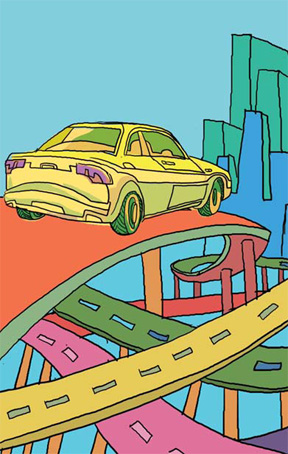Comment
Noodle junctions in city jungle
By Edward Mills (China Daily)
Updated: 2010-02-01 13:15
 |
Large Medium Small |

Everyone who regularly drives, or takes a taxi for an extended period of time, will know what I mean when I say that Beijing has arguably one of the most complicated road systems in the world, especially when taken in comparison to many Western nations.
It's not just the sheer volume of traffic or pedestrians weaving in and out of 10-lane traffic that make it complex, but the very formation of Beijing's infrastructure that is so incredible.
Naturally this experience won't be found if one doesn't venture far from the indefectible, precise roads around Tian'anmen Square. These are built in a way that would have pleased the Romans: resolutely straight.
Visit different districts of the city, however, one notices a marked change. The roads take on a life of their own.
Suddenly lanes will split, some heading into a tunnel, others veering off to one side, only to rejoin each other in a short time.
Taxis will dart through a near-invisible gap in the foliage and follow a narrow, winding track that emerges at a set of traffic lights - at a major junction!
The most famous Beijing example of these interwoven arteries can be found at what is considered by many Chinese to be one of the greatest mazes around the globe: Xizhimen Viaduct. Navigating this puzzle can be amazingly hard work, as there is no such thing as simplicity where this intersection is concerned.
You cannot simply turn right in order to continue your journey. Driving from the west, in order to turn southbound one has to complete in the region of 10 right turns before the correct road has been selected - managing to do this at that first attempt is an enviable feat that may be difficult to repeat at a further date.
Of course the Western world's urban planning can result in such situations as well.
Gravelly Hill Interchange outside of Birmingham in the UK has certainly earned its colloquial title of "Spaghetti Junction" as the affair serves 18 routes across five different levels, accommodating two railway lines, three canals and two rivers.
There are a vast multitude of examples across the world, but the simple fact remains: Beijing is the only modern city that has them in such abundance.
Having come to this conclusion, one could take the pessimistic view that undoubtedly this convoluted labyrinth of highways must contribute significantly to Beijing's growing traffic problem. This would seem a fair assumption.
It is certain that tidy junctions and simplified traffic routes, alongside rigorous traffic rule enforcement, could help reduce the clogged roads at peak times.
Someone who negotiates these perplexing obstacles on a daily basis would likely be keen to see some improvement to lessen the stress of their journey.
Indeed, at times it would be easy to agree with that view. But there's certainly a part of me that is still pleasantly surprised at the unbelievably complex route that one has to take.
It certainly makes the journey more enjoyable, if not the swiftest.














